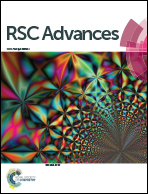Enhanced biocompatibility of biostable poly(styrene-b-isobutylene-b-styrene) elastomer via poly(dopamine)-assisted chitosan/hyaluronic acid immobilization†
Abstract
The biostable poly(styrene-b-isobutylene-b-styrene) (SIBS) elastomers are well-known for their large-scale in vivo application as drug-eluting coatings in coronary stents. In this study, the SIBS elastomers were modified with a poly(dopamine) (PDA) adherent layer, followed by integrating both chitosan (CS) and hyaluronic acid (HA) onto their surfaces. The as-prepared samples (SIBS-CS-g-HA) presented excellent cytocompatibility because CS facilitates cell attachment and HA enhances cell proliferation. The initial adhesion test of E. coli on SIBS-CS-g-HA showed effective antiadhesive properties. The in vitro antibacterial test confirmed that SIBS-CS-g-HA has good antibacterial activity.


 Please wait while we load your content...
Please wait while we load your content...